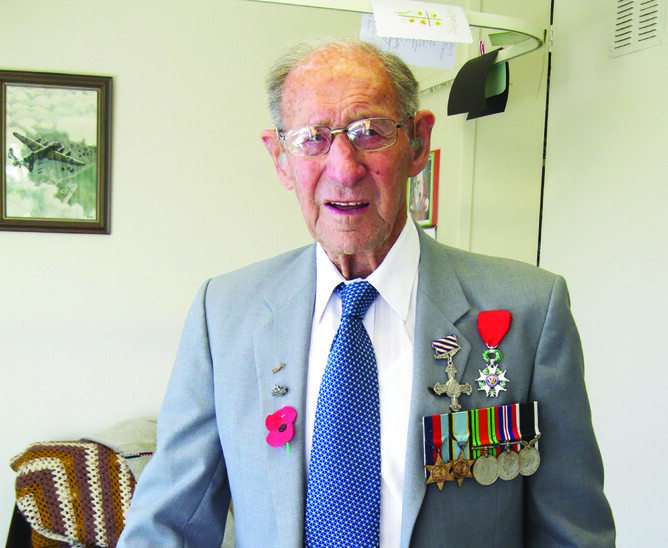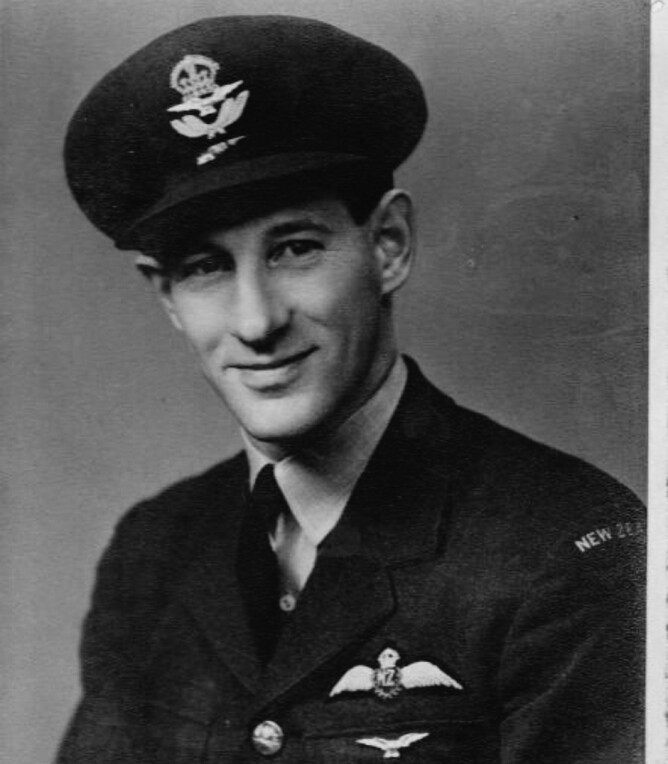Greeting Trevor Strong is like meeting a long lost friend. His warmth and graciousness are the first things I notice as I shake hands with one of the men who, in the midst of the horrors of WWII, dreamed that aircraft could be used for a better purpose than war.
Trevor Strong is also a true gentleman, and the first thing this soon-to-be- centennial does when I meet him in his rest home on the North Shore of Auckland, New Zealand is to offer me his chair. He asks me about myself and my work, and laughs easily as we exchange personal stories. His smile is contagious and, despite his years, his eyes still hold a twinkle of good humour and delight. Put quite simply, Trevor Strong is charming.
He is also handsomely decorated and somewhat famous from his career as a veteran pilot in WWII, but you would never know this just from talking to Trevor. He is genuinely humble, and not at all concerned with making known his heroic actions in the war.
It’s the same when we discuss Mission Aviation Fellowship and its early beginnings in which Trevor played a key role. While Trevor is clearly delighted to hear of MAF’s impact, and perhaps even surprised at just how widely spread this mission organisation has now become, he is not at all concerned with receiving any accolades for his vital role in the organisation’s birth and first steps.
Yet, with the help of old newspaper clippings, snippets of memories, and the assistance of his daughter, Beverly van Vugt, Trevor’s fascinating and inspiring story begins to unfold.
Flight Lieutenant Trevor Strong was more than just a brilliant pilot—one of the best, in fact—he is also a deeply committed Christian. Trevor was 19 years old when he heard the Gospel message clearly for the first time from a blind soldier-turned- evangelist who was holding rallies in New Zealand in the early 1930s. It was a life-changing week for Trevor, who attended every meeting before joyfully finding his pardon and peace through Jesus Christ at the foot of the cross. This experience made a huge impact on him, and he soon found that old hobbies and interests fell away. As Trevor remembers: “I found my joy in the service of the Lord Jesus Christ.”
It was soon after this that a second World War exploded across the world and Trevor’s newfound faith proved to be a worthy foundation. Trevor had always wanted to fly and was quick to sign up for training in New Zealand to defend his country as a pilot. He continued his training in England, then began a tour of operations against Nazi Germany.
During this dangerous time, Trevor’s found his faith to be a tangible strength: “We were very often brought face to face with the reality of death, but I had no fear... This did not make me careless, but confident, because my life was in His hands.”
As an extremely skilled pilot, Trevor was assigned the role of a pathfinder—a high risk job that involved flying out over enemy territory to seek out a clear path for the Allied forces to use. Trevor successfully led forty-four pathfinding missions, until August 25, 1944 when his plane was hit by Nazi guns over enemy lines. Instantly Trevor, a confident and efficient leader, snapped into action and successfully evacuated his entire crew before finally jumping from the doomed aircraft himself. Separated and alone, he evaded the enemy for two days, making his way toward the Allied lines. It was a harrowing experience: “I’ll never forget the sound of dogs, howling in the woods as they came after me...” Unfortunately, Trevor was apprehended and taken to an interrogation centre in Germany where his story ought to have ended.
“It gives me great joy to think that aircraft can be used to carry the Gospel to the ends of the earth, so that we may have the joy of taking life and not death to the peoples of the world”
Yet once again, God was faithful and Trevor’s faith held firm: “While in solitary confinement, the presence of the Lord was very real indeed.” He was soon moved to a prison camp, and here he found a number of other believers. They spent the next nine months sharing Bible studies, prayer and fellowship, but it was tough times that the men faced. “As the war came to a close, things became very difficult,” Trevor recalled, “It was very cold and we were often hungry. It was a grim experience, but in all these things we were able to triumph in Christ.”
As the war ended, Trevor and his POW camp were liberated by the arrival of the Russians. With the traumas of war fresh in his mind and the grace of God strong in his heart, Trevor flew back to England. There, he met up again with fellow Kiwi pilot, Murray Kendon, and that same day heard his friend’s unique vision – to use aircraft as a tool of the Gospel.
Trevor immediately knew that this was God in action and his mind flew back to the night he had flown through flashing tracers, quietly promising God that if he came out of this war alive he would use his influence in Christian mission work. Now, as peace began, Murray was proposing a new kind of mission organisation that would use aircraft for help and hope, rather than for war, and Trevor joyfully resonated with this: “I felt that this was what the Lord had called me to do.”
After WWII ended, Flight Lt. Trevor Strong was decorated with the Distinguished Flying Cross. Yet this war hero found his greatest reward in daring to dream big and do bigger for the Kingdom and he threw himself into establishing a brand new aviation-based mission with all his heart.
The two friends worked together to present the concept of using light aircraft to help in humanitarian and mission work, but found it next to impossible to find a willing audience. But all this changed when Murray spoke to Dr. Thomas Cochrane, president of the Movement for World Evangelism at the Mildmay Centre in London. Murray shared his idea for using airplanes to enable missionary work, and Dr. Cochrane’s answer was swift and direct: “God has laid this on your heart, Murray, perhaps He wants you to do something about it yourself. You pray about it, write an article, and I will publish it.”
The article, published in England’s “A Christian Weekly” on 5th July 1945, was the first recorded thought about an MAF-type operation, and it unleashed a wave of Christian pilots, engineers and supporters. From that moment, everything changed for Trevor, Murray and the fledgling Missionary Aviation Fellowship (later changed to Mission Aviation Fellowship), and the two Kiwis had soon set up a small headquarters in London from which to launch the organisation. They spent the year travelling around the UK gathering support and sharing the dream with English aviation enthusiasts and supporters. In 1946 they sent a Miles Gemini aircraft to make MAF’s first survey flight into Africa.
That same year, war-hero-turned-mission-founder Trevor Strong returned to New Zealand to marry his sweetheart, Joan Flemming. He then set about igniting the MAF vision in Aotearoa. Trevor established the MAF Committee in 1947, and later became the first chairman of the MAFNZ Board. In 1959 MAF New Zealand was officially incorporated as a Society and, though
Trevor was not able to continue flying due to hearing damage sustained from the war, he served on the MAF NZ Board and continued to play a key part in MAF in New Zealand for many years. He and Murray remained close friends until Murray sadly passed away in New Zealand on 27th May, 2014.
On 29th November, 2014, Trevor Strong celebrated his 100th birthday. More distinguished, wiser, and with that indomitable grin, he greeted his centennial year with the same gracious faith he had carried throughout a tragic World War, a ground-breaking new mission organisation and a genuine life lived to the full.
Visiting with Trevor a few weeks before his birthday, I mentioned to him that the vision he and Murray had shared began with one small plane, but that Mission Aviation Fellowship was, today, a global organisation with 140 aircraft. “Well,” he said, then paused and grinned to himself, “fancy that.”
Though Trevor and Murray, two down-to-earth WWII pilots from New Zealand, were passionate about the idea of MAF and confident that God would use it for His glory, they had absolutely no idea of the extent to which God would bless this daring endeavour. They dreamed of an aviation-based mission that would turn the deadliest of weapons into tools of peace; yet even they were awed and blessed by the way MAF aircraft and ministries have revolutionised humanitarian work, aid services and mission work around the world.
By Emma McGeorge
Thanks to Trevor Strong, Beverley van Vugt (nee Strong) and Ted Crawford for their assistance with this story. Credit also to the New Zealand “Challenge” newspaper, Edition 29 August 1946. All photos courtesy of Beverley van Vugt.

